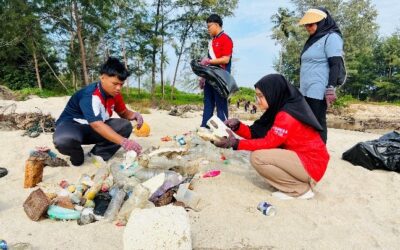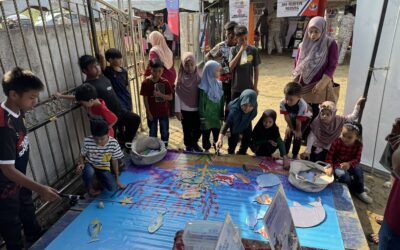Local communities should be involved in decisions on the management of natural resources that may affect their livelihoods
After a busy few months focusing on a proposed airport development on Tioman Island, it’s appropriate to return to the post-2020 Global Biodiversity Framework (GBF) to look at some of the Targets that inform our work.
Target 22 is particularly relevant.
IPLCs role is increasingly recognised
One of the most important developments coming out of the Kunming-Montreal treaty negotiations – and one which was demonstrably important in the Tioman campaign – was the growing acknowledgement of the important role played by Indigenous People and Local Communities (IPLCs) in biodiversity conservation.
Target 22 of the GBF reads:
“Ensure the full, equitable, inclusive, effective and gender-responsive representation and participation in decision-making, and access to justice and information related to biodiversity by indigenous peoples and local communities, respecting their cultures and their rights over lands, territories, resources, and traditional knowledge, as well as by women and girls, children and youth, and persons with disabilities and ensure the full protection of environmental human rights defenders.”
In simpler language, local communities should be involved in decisions on the management of natural resources that may affect their livelihoods. In practice, what this means is that they should have a voice in the management of protected areas.
Real-life example
We were recently involved in a collaborative effort to lobby against a proposed airport development at Tioman Island. That effort demonstrates just how important it is to have systems in place that ensure local communities are involved in decision-making, particularly on issues that affect their futures.
Once we started working on the airport campaign, it quickly became clear that many people in the local communities affected had little or no knowledge about the proposed project. This is a project that would have essentially closed down two communities that rely on tourism; over 20 resorts and 400 people would have been affected.
In the context of Target 22, we have to ask: Were local communities consulted about the proposed development?
Apparently, yes.
But was this the sort of “full, equitable, inclusive effective and gender-responsive representation and participation in decision-making” that Target 22 envisages?
It seems not.
Their vocal opposition to the development, once they were fully informed as Target 22 stipulated, was critical in persuading the planning authorities, and eventually the government, to abandon the plan.
Our team held a community engagement session to explain the EIA of the proposal for the new Tioman Airport.
Link to policy
The idea of involving local communities in decision-making on natural resources management is incorporated into several relevant policies and agreements in Malaysia.
On a national level, the National Policy on Biological Diversity speaks about strengthening the role of indigenous peoples and local communities in biodiversity conservation. The 12th Malaysia Plan refers to “imperatives for reform and transformation”.
In addition, Malaysia has adopted the Sustainable Development Goals, which specifically mention inclusivity in Target 16.6 (develop effective, accountable and transparent institutions at all levels) and Target 16.7 (ensure responsive, inclusive, participatory and representative decision-making at all levels).
Despite this, progress still needs to be made to ensure the full and informed participation of IPLCs in decision-making on marine resource management. Two challenges in particular need to be addressed: structures and functions.
Structures and functions
One of the key challenges is simply the lack of appropriate bodies for IPLCs to join. Management of marine resources in Malaysia is centralised, and there is no institution that provides a “place at the table” for IPLCs.
The Marine Parks Advisory Council includes members from various government agencies, from State governments and from selected NGOs. But no membership for local communities.
On the ground, the Marine Park centres on the islands are managed and operated by Marine Park staff; there is no local consultative body. Previously, a Community Consultative Committee was proposed but never operationalised.
At the other end of the spectrum is the tendency of bureaucratic institutions to gather functions to themselves rather than to delegate those activities to others.
This is not restricted to Malaysia, but it does represent a considerable barrier to greater participation of IPLCs in decision-making. This is why it is our practice to conduct consultations when developing new projects, to learn what communities need and to understand what outcomes we are seeking. This has implications for project plans and budgets.
Community consultation was done to improve our conservation initiatives in Mersing
Reef Care – a way forward
And this is why we are so excited to be a strategic partner of the Department of Fisheries in the Reef Care programme. Because Reef Care overcomes both the above challenges at the same time:
-
In establishing the Reef Care programme, the DoF has addressed the lack of an appropriate institution for local community representation. The community groups that we support on several islands are the communities participating in management and decision-making.
-
At the same time, Reef Care gives the community partner some responsibility for coral reef conservation, taking on some of the duties and responsibilities of the managing agency. So, the DoF has, in fact, divested itself of some responsibilities.
The Tioman Marine Conservation Group (TMCG) is pointing the way. Over 80 members of the local community are participating in coral conservation programmes, from removing ghost nets to coral rehabilitation and annual monitoring surveys. You can read the TMCG 2022 report here.
We have recently established a similar group on Redang Island, the RMCG, and we are working in two other locations in Peninsular Malaysia and in the south of Sabah on similar programmes. You can read the Q1/Q2 Cintai Redang Newsletter here.
In each location, we build capacity among the local community in marine resource management; funding from donors and corporate partners allows us to pay operating costs as well as allowances to local community members when they participate in programmes so that we can incentivise their participation.
RMCG members consist of Redang islanders who we train to do conservation work with us
Thus, Reef Care is providing an opportunity to actually implement policy in real life, contributing not only to national policy but also to the SDGs and the GBF. We look forward to rolling out the programme in other areas and to ensuring IPLCs are increasingly engaged in marine resource conservation.







